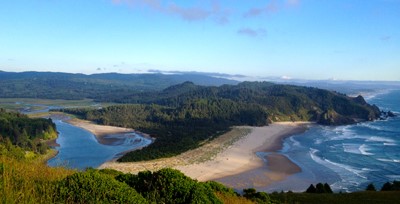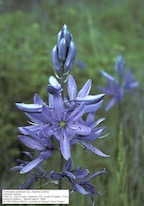NPSO 2024 Annual Meeting
May 17 - 19 Spirit Mountain Hotel, Grand Ronde, Oregon
 View of Salmon River Estuary from Cascade Head. Photo: Kareen Sturgeon
View of Salmon River Estuary from Cascade Head. Photo: Kareen Sturgeon
In June 1842, Charles Wilkes of the United States Exploring Expedition (1838-1842) described what is now Yamhill County’s Eola Hills as being “covered with wallflowers, lupine, scilla, and quantities of ripe strawberries.” Another member of the expedition wrote in his journal of a “prairie all luxuriantly clothed in a rich and heavy coat of vegetation and latterly clothed in flowers, the upland in yellow and the valleys in purple.” As is true elsewhere in the Willamette Valley, historically extensive prairies and oak savannas have been replaced by urban, commercial, and agricultural development, with only a small fraction of the historic landscape remaining. But recent years have shown a resurgence in restoring degraded landscapes and protecting what remains. This is the focus of the 2024 NPSO Annual Meeting.
When early explorers arrived in the area, they recognized that the Valley and surrounding landscapes were not (in modern parlance) climatic climax communities. For example, they were at a loss to explain the presence of such extensive prairies in the Valley when the climate indicated it should be forested. When members of the Hudson’s Bay Company entered the Willamette Valley in September 1826 on their annual trapping expedition south to California, they encountered extensive burning by indigenous peoples. David Douglas, botanist and member of the expedition, exclaimed that there "was not a single blade of grass” on which to feed their horses and lamented that fire was “highly unfavorable to botanizing”! On his return in November, he encountered an altered landscape, now green, “open, rich, level and beautiful.”
In fact, Native Americans had been managing the landscape for millennia, primarily through their use of fire, which kept the valley, foothills, and surrounding forests in early seral stages. This, in turn, made for a more efficient deer hunt and made it easier to gather traditional foods, such as acorns. Fire created environments that encouraged the regrowth of culturally important plants used in basketry, such as hazel, and increased the future yields of foodplants, including camas bulbs, tarweed seed, and many species of berries. Coast Range forests, too, were burned primarily to encourage the growth of berries, such as salal, red huckleberry and salmonberry, and to clear travel routes, especially along ridges.
Today, less than 10% of the pre-settlement forest and less than 1% of the prairie and oak savanna landscapes remain. Recently, conservationists have worked to preserve what remains and, where possible, to restore degraded areas.
Many organizations are actively involved in restoration efforts. For example, the Confederated Tribes of Grand Ronde (CTGR) are actively involved in restoring native habitats and growing culturally important native species for introduction to degraded landscapes on their ceded lands so we chose to host the meeting at the Spirit Mountain Lodge. The CTGR have partnered with others for restoration, including the Institute for Applied Ecology and the USFWS. On Friday night, our speaker will be Dr. Tom Kaye of the Institute for Applied Ecology who will discuss IAE’s restoration efforts in conjunction with CTGR and in other locations focusing on restoring populations of Bradshaw’s lomatium, Fender’s blue butterfly, golden paintbrush, and Nelson’s checkermallow. On Saturday night our banquet speaker, Dr. David G. Lewis, a member of the Confederated Tribes of Grand Ronde, will discuss “Kalapuya tribal culture and the Willamette Valley environments in which the Kalapuya lived.” He will present research reconstructing their environment after 180 years of settler changes. The presentation will also address the removal of water and return of cultural fire and what this means to tribal descendants today.
The Hotel in Grand Ronde is an ideal central location for our meeting. We offer field trips in the valley, at the coast, and in the Coast Range, including oak savannas, prairies, coastal forests, and estuaries. Many of the field trips visit areas that are being restored or are actively managed for culturally significant plant species or for the protection of state and federally listed species. Because wine production is a major agricultural land use in the Valley, two trips include a visit to a winery that is preserving Oregon white oaks on their land.
Only NPSO members may participate in Annual Meeting activities. You may join NPSO or renew your membership at https://nativeplantsocietyoforegon.wildapricot.org/ or when you mail in your Registration Form.
Questions? Email annualmeeting@npsoregon.org .


